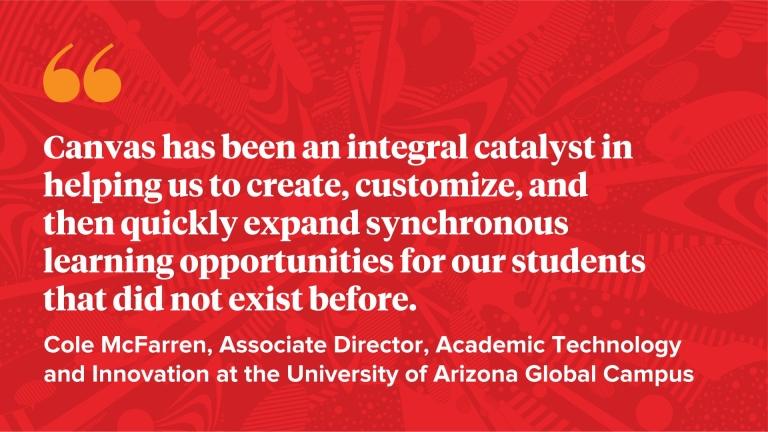
Today’s student lives, works, and learns in a world that undeniably offers more options and customization than ever before. Students who attend the University of Arizona Global Campus (UAGC) are no different, and why shouldn’t they expect the same options in their education as they enjoy in other parts of life? A university’s challenge now more than ever is to efficiently meet students where they are, in the format they desire, when they want it. One of the draws to the approach of UAGC to coursework is that it allows students across the country and world to work asynchronously to achieve their degrees in fast-paced, 100% online courses. Students can work efficiently and quickly toward their degree on their own time.
The downside to this approach, however, is that students may only meet synchronously with faculty or students a handful of times throughout their degree program. What about students who want the flexibility of our degree programs but also desire the ability to connect with others in real-time? Over the past two years, UAGC has taken advantage of the versatility and accessibility of Canvas to implement its unique approach to Live Learning across its General Education courses.
With the boom of artificial intelligence (AI) and its indisputable current and future impacts on higher education, it almost feels antiquated at times to be focusing time and energy on creating more opportunities for human interaction. Yet, each time my colleagues or I have had the opportunity to present at conferences or in other venues about our work, we garner a lot of interest and spark conversations about how our “back-to-basics” approach highlights that human connection is more important now than ever.
Live Learning took off for us when a team of faculty in our School of General Studies piloted a new approach to connecting synchronously with our students. Like other institutions, many of our faculty have offered office hours for years with minimal student traffic. One of the silver linings of the pandemic was that the general population became much more comfortable connecting digitally and synchronously. A team of our faculty spearheaded the expansion of Live Learning into the remainder of our General Education courses after our analyses time and time again indicated students who attended Live Learning were more successful than those who did not.

UAGC has implemented a centralized Live Learning model that offers benefits not seen in other approaches. Instead of having every faculty member in every section of their course host a session, a set of full-time faculty or contracted associate faculty host sessions that are shared across a course. For example, there may be twelve sections of ENG 121 active at one time. Each section is directed to the same Live Learning page and calendar we have created in Canvas. Students may be paired up with faculty members and students outside of their specific section. All sessions are scheduled by my team to ensure a consistent student experience across courses. Here are some of the aspects of what makes Live Learning at UAGC unique:
- Centrally scheduling and facilitating Live Learning means we can offer sessions at more dates and times to accommodate our students’ already busy schedules. We typically offer sessions on alternating weekdays and evening and morning sessions. This approach also ensures our best faculty are leading Live Learning and engaging our students in real-time.
- Students are asked to attend one Live Learning session throughout their five-week course. This allows students to plan ahead and align their schedules. When students’ schedules do not allow them to attend live, they are able to meet the requirement by watching a recording of a previous session.
- One of the most significant advantages of this approach is it does not add to the standard associate faculty member’s workload. We don’t have to ask our faculty to add one more item to their to-do list, and we don’t have to train and support all faculty in these sessions.

Part of my role in implementing Live Learning throughout our General Education courses included creating a framework that provided a seamless experience for our students without taking hours of setup in the background each time a course took place. The Canvas classroom allows us to do just that and easily integrate several tools from our suite of products:
- We utilize the Zoom integration within Canvas to ensure easy access within a platform students are comfortable with.
- Google Calendars allow us to embed the Live Learning schedules directly into the classroom so there is less confusion about when sessions are being hosted. Multiple time zones are listed to help alleviate the confusion students encounter.
- Finally, we post recordings of our Live Learning in Kaltura and confirm they are 100% accurately closed captioned to ensure accessibility for all students.
In short, Canvas has been an integral catalyst in helping us to create, customize, and then quickly expand synchronous learning opportunities for our students that did not exist before. In the debate of whether technology can enhance and create new means for human interaction, the answer in this instance is a resounding yes.
Cole McFarren - Associate Director, Academic Technology and Innovation at the University of Arizona Global Campus
Related Content
 Teaching-With-Tech-10-Benefits.jpg
Teaching-With-Tech-10-Benefits.jpgBlogs
 cidilabs.png
cidilabs.pngBlogs
 canvas_x_tg_logo_lockup_780_x_520.png
canvas_x_tg_logo_lockup_780_x_520.pngBlogs